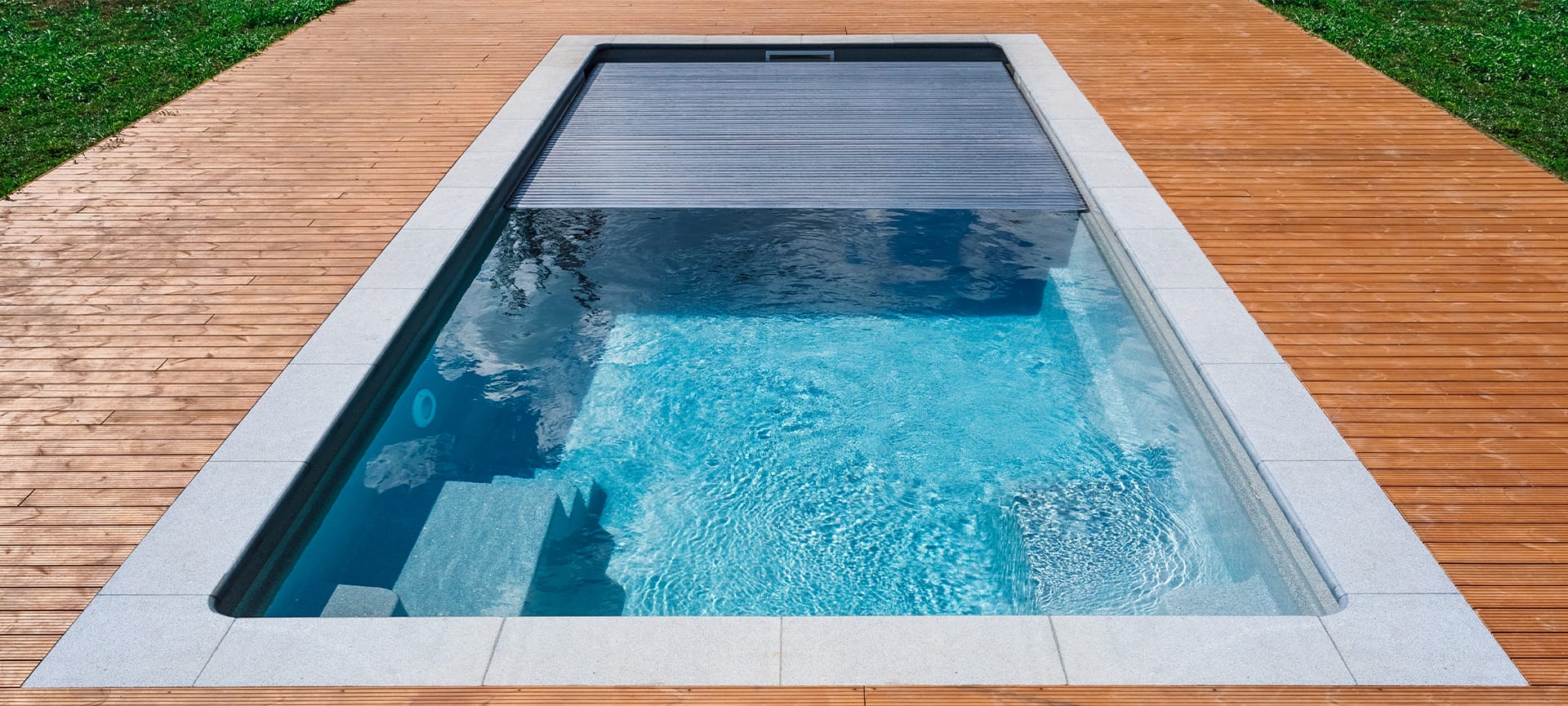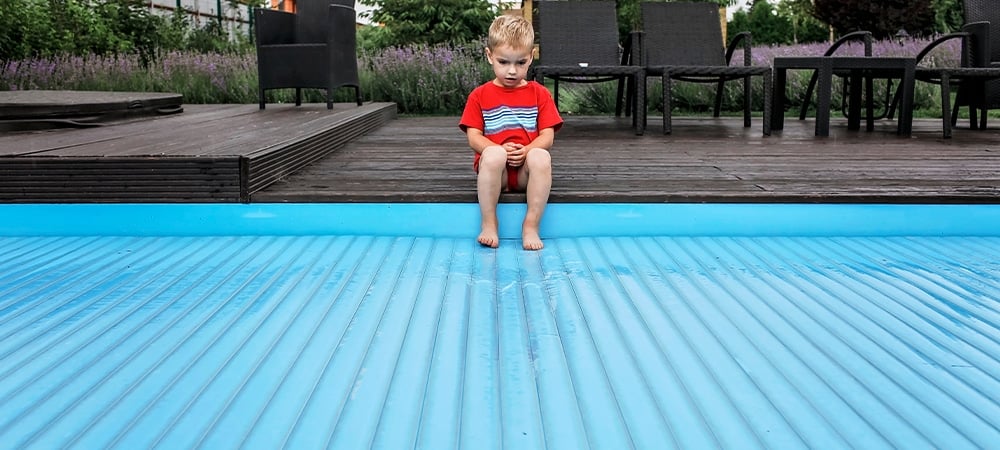How Much Do Automatic Pool Covers Cost

If you own a swimming pool, you already know how much time and effort go into keeping it clean, safe, and functional. But no matter how committed you are to maintenance, one upgrade will make your life easier and your pool more secure: an automatic pool cover.
It’s not a minor expense, but it’s one of the smartest pool investments you can make.
Let’s break down how much automatic pool covers cost, what affects the price, and why homeowners in York Region and Toronto are choosing to install them.
Related Article: Top 5 Swimming Pool Water Features You Need
How Much Do Automatic Pool Covers Cost?
Most automatic pool covers cost somewhere between $8,000 and $20,000. That includes the cover material, track system, motor, control panel, and professional installation. Costs vary depending on the system you choose, your pool’s shape and size, and whether you’re installing during construction or retrofitting an existing pool.
Here’s a rough breakdown of what you can expect:
- Standard Top-Track Systems
These are mounted above the pool deck and are usually the most budget-friendly. You’re looking at $8,000 to $12,000 for most standard installations. - Under-Track Systems
These are built into the pool design and hidden beneath the coping. They provide a cleaner look and are more aesthetically pleasing, but cost more; usually between $12,000 and $15,000. - Custom Pool Shapes
If your pool is freeform, kidney-shaped, or anything non-rectangular, you’ll need a custom solution. This can bring the price up to $15,000 to $20,000 or more, especially if retrofitting is involved.
Keep in mind these figures are averages. At Green Side Up Landscaping, we provide exact quotes based on your pool’s design, your preferred system, and your long-term goals.
Related Article: Pool Construction Cost: Everything You Need to Know
What Factors Affect the Cost?
Automatic pool covers aren’t one-size-fits-all. A number of variables impact the final price. Here’s what drives costs up or down:
Pool Size
The bigger the pool, the more material you need. A larger surface area also means a more powerful motor and potentially a more complex track system. Even between two rectangular pools, a few extra feet can shift the price significantly.
Shape and Design
Rectangular pools are the easiest and most affordable to cover with an automatic system. If you have a freeform or irregular-shaped pool, custom engineering is required. That adds time, design work, and expense.
Track System Type
There are two main types of track systems:
- Top-track systems are surface-mounted. They’re easier to install and more affordable.
- Under-track systems are embedded during construction, offering a sleek look and no visible hardware. They’re pricier because they’re more complex to install.
Motor and Control Options
Basic systems use a key switch to open and close the cover. Higher-end models may include remote controls, smart home integration, or wireless sensors — all of which add to the cost.
New Build vs Retrofit
If you’re installing the cover while building your pool, costs are lower. Retrofits usually require structural changes, electrical work, and sometimes deck modification, which drives up both time and labour.

What’s Included in the Cost?
When you get a quote for an automatic pool cover, you’re not just paying for a piece of vinyl. Most installs include:
- The vinyl cover, made from heavy-duty, UV-resistant material
- A motorized mechanism, usually electric, occasionally hydraulic
- Track system (top or under-mount)
- Control panel, switch, or keypad
- Installation labour, including prep work and system testing
- Warranty (often 3 to 5 years on components, depending on the brand)
At Green Side Up, we also offer follow-up service, maintenance plans, and troubleshooting for every system we install, because long-term performance matters just as much as day-one results.
Why Invest in an Automatic Pool Cover?
It’s not just a convenience feature. A properly installed automatic cover provides real, everyday benefits.
Safety for Kids and Pets
This is the #1 reason most families get a pool cover. An automatic cover creates a solid barrier between your pool and your backyard. And most models can hold the weight of multiple adults. It reduces the risk of accidents and helps you meet local safety codes.
Energy and Chemical Efficiency
Covers dramatically reduce heat loss, water evaporation, and chemical consumption. By keeping debris out and heat in, you lower your utility bills and extend the life of your pool equipment.
- Up to 90% reduction in water loss from evaporation
- Up to 70% reduction in heating costs
- Up to 50% savings on pool chemicals
Less Cleaning, More Swimming
Leaves, insects, and debris are a constant battle for pool owners. A covered pool stays clean longer, meaning less vacuuming and skimming and more actual use.
Quick, One-Person Operation
Unlike manual covers, which are bulky and awkward, an automatic cover opens or closes in under a minute. It’s ideal for people who want security and simplicity, without the hassle.
Related Article: Common Pool Issues and How We Fix Them For You
Maintenance and Replacement Costs
An automatic pool cover isn’t “set it and forget it.” Like any mechanical system, it needs upkeep. Here’s what to expect:
- Annual maintenance service: $200 to $500
- Cover replacement (every 5–7 years): $2,000 to $4,000
- Motor or gear replacement (after 7–10 years): $500 to $2,000
Keeping the cover clean and avoiding sharp debris will help extend its lifespan.
What Homeowners Typically Gain from Installing an Automatic Cover
Homeowners who install automatic pool covers often see noticeable improvements right away. Benefits typically include:
- Reduced heating costs, since the cover traps heat and cuts down on overnight temperature loss.
- Lower chemical usage, due to decreased evaporation and exposure to debris.
- Less time spent on maintenance, with fewer leaves, dirt, and insects entering the pool.
- Improved safety, especially for households with children or pets.
- Longer swimming season, thanks to better heat retention and cleaner water.
While the upfront cost can be significant, the long-term savings — combined with the convenience and peace of mind — make it a strong return on investment for many homeowners in York Region and Toronto.
Related Article: Signs It’s Time to Restore or Renovate Your Pool

Financing and Project Planning
If the upfront cost feels out of reach, you’re not alone. Many homeowners roll their cover installation into a larger landscape project or finance it through a pool loan. At Green Side Up, we can connect you with trusted financing options or help you plan a phased approach.
We also recommend bundling pool cover installation with decking, lighting, or outdoor living upgrades. Doing it all at once saves time and gives you a seamless finish.
When to Install an Automatic Cover
The best time to install is during new pool construction. It’s cleaner, quicker, and cheaper. But retrofits are absolutely possible especially if your pool has a rectangular footprint.
Planning ahead is key. In York Region and Toronto, spring and early summer are high-demand seasons, so if you’re looking to have a system ready by swim season, it’s best to book your install early in the year.
Bottom Line: It’s an Investment in Safety and Simplicity
Yes, automatic pool covers are expensive. But they also save you time, money, and stress over the life of your pool. If you value safety, clean water, energy savings, and convenience, this is one upgrade that pays for itself and then some.
At Green Side Up Landscaping, we’ve helped homeowners across York Region and Toronto transform their backyards into low-maintenance, high-comfort spaces. From outdoor kitchens to pool covers, we build outdoor spaces that work for more than your weekends but your lifestyle.
Ready to Cover Your Pool the Smart Way?
Let’s talk. We’ll walk your property, review your pool setup, and show you what cover options make the most sense for your space and your budget. Call us today or book your consultation online. Make this the season your pool works smarter, not harder.
